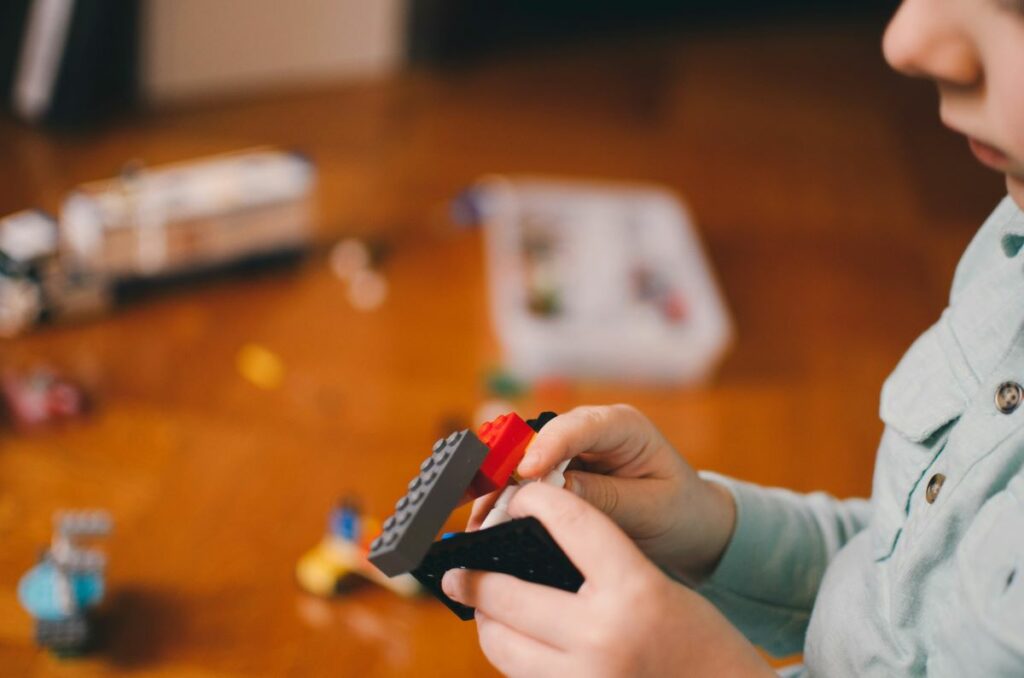Play therapy is a therapeutic approach that uses play as a means to facilitate communication, self-expression, and emotional regulation in children with various developmental and emotional challenges.
Children diagnosed with autism spectrum disorder (ASD) may particularly benefit from play therapy, as it addresses their unique needs and offers a non-threatening environment that fosters growth and development.
6 Play Therapies for Autism
Play therapy is a powerful tool in helping children with autism spectrum disorder (ASD) develop crucial social, communication, and emotional skills. Various play therapy approaches can be tailored to suit each child’s unique needs and preferences.
In this section you will find some specific techniques used in play therapy for autism.
1. Floortime Therapy

Floortime therapy is a relationship-based therapy developed by Dr. Stanley Greenspan and Dr. Serena Wieder.
This approach focuses on meeting the child where they are, both emotionally and developmentally, by following their lead in play and using the child’s interests to promote engagement and interaction.
Floortime encourages children’s natural exploration and curiosity while promoting a strong emotional bond between the therapist, parents, and the child.
By joining the child in their world and following their interests, the therapist can target and facilitate social, emotional, and cognitive development in a natural, enjoyable context.
2. The PLAY Project

The PLAY Project (Play and Language for Autistic Youngsters) is a parent-mediated intervention founded by Dr. Richard Solomon that utilizes the principles of child-centered play therapy.
In this approach, parents are trained and supported by the therapist to engage their child through play, focusing on building a strong connection and fostering the child’s social and emotional growth.
The PLAY Project empowers parents to become their child’s primary therapeutic agent, creating a supportive and consistent environment where the child can develop essential life skills.
3. Child-centered Play Therapy

Child-centered Play Therapy is a non-directive approach where the therapist creates a supportive environment for the child to express and process their emotions, develop social skills, and enhance self-esteem.
This method is built on the belief that children have an innate ability to solve their own problems, and the therapist’s role is to guide them through the process via play.
4. Synergetic Play Therapy

Synergetic Play Therapy integrates various therapeutic models such as neurobiology, attachment theory, and nervous system regulation.
This approach helps children with autism to better understand their internal experiences and navigate challenging emotional states.
Therapists utilize play as a medium for engaging the child and fostering emotional regulation, healthy communication, and self-awareness.
5. Art-play Therapy

This type of therapy combines the techniques of both art therapy and play therapy, incorporating creative expression to facilitate the growth and development of the child with autism.
Through art-making and play, children are guided to explore feelings, thoughts, and behaviors that may be challenging to express using words alone.
The creative process allows for increased self-understanding and improved interpersonal relationships.
6. Equine-partnered Play Therapy

In Equine-partnered Play Therapy, children engage in activities with horses under the guidance of mental health professionals.
This method fosters emotional, cognitive, and behavioral growth by utilizing the relational bond between the child and the horse.
The unique sensory and social experiences provided by working with horses can help children with autism improve communication, sensory processing, and motor skills.
Role of Play in Communication and Social Skills
Play therapy is an effective method for addressing various issues faced by children, especially those with autism. It focuses on enhancing communication and social skills in children with autism, thereby helping them overcome challenges in these areas.
Through play, children can learn vital social skills such as sharing, cooperation, and empathy, which are essential for their overall development.
Verbal Communication
One of the significant aspects of play therapy for children with autism is promoting verbal communication. Engaging in play allows these children to practice their language skills in a relaxed and enjoyable environment.
Verbal communication is critical for individuals with autism, as it helps them express their thoughts, feelings, and needs effectively.
Joint Attention, Symbolic Play, Engagement, and Regulation (JASPER)

Another essential aspect of play therapy is fostering joint attention, symbolic play, engagement, and regulation (JASPER).
| Concept | Description |
|---|---|
| Joint Attention | Joint attention is the ability to share focus on an object or activity with another person. This skill is crucial in social communication and language development. Through play, children with autism learn to engage with others in a shared activity, promoting joint attention and better social interactions. |
| Symbolic Play | Symbolic play is a fundamental aspect of a child’s cognitive and social development. It allows children to explore different scenarios, roles, and perspectives—skills that are essential for building empathy, problem-solving, and communication abilities. Children with autism may show deficits in symbolic play, which could lead to difficulties in understanding social situations. Play therapy can help them develop their imaginative abilities and improve their communication skills in the process. |
| Engagement and Regulation | Engagement and regulation are critical factors for enhancing social skills in children with autism. Engaging in play therapy encourages these children to participate in activities, learn to follow rules and guidelines, and practice self-regulation. These skills are vital for their ability to interact with others in social settings effectively. |
Play Therapy Vs ABA

Child-centered play therapy and Applied Behavioral Analysis (ABA) are two intervention approaches for children with autism.
While both have their benefits, they work in different ways and may be suited to different children.
| Child-centered play therapy | Applied Behavioral Analysis (ABA) |
|---|---|
| Play therapy is a non-directive approach, focusing on establishing a therapeutic relationship through child-led play as a means of enhancing communication, social skills, and emotional development. | ABA is a more directive approach, utilizing principles of learning to identify and modify challenging behaviors and develop new skills in children with autism. |
| Some studies have found that intensive child-centered play therapy can be effective for children diagnosed with autism spectrum disorder (ASD). | It involves breaking down complex tasks into smaller components and reinforcing appropriate behaviors. |
| It has been noted that group play therapy can significantly influence the communication of children with high-functioning autism. | ABA has been widely researched and is generally considered effective in improving a range of skills in children with autism, including communication, adaptive living skills, and social skills. |
| Play therapy tends to be more flexible, allowing the child to take the lead and express themselves through free play. | ABA usually follows a structured protocol and involves close guidance from a therapist or practitioner. |
| In play therapy, therapists aim to create a safe environment where the child feels comfortable to explore and express themselves while also fostering their emotional and social growth. | ABA focuses on specific behavioral goals and measurable outcomes, often relying on data collection and analysis to gauge progress. |
In deciding between play therapy and ABA, it’s crucial to consider the unique needs of each child.
While it’s not uncommon for children with autism to benefit from both approaches, some may respond better to one over the other.
A thorough evaluation and consultation with qualified professionals can help guide parents, educators, and therapists in choosing the most appropriate intervention for the child in question.
Frequently Asked Questions

What are the benefits of play therapy for children with autism?
Play therapy, such as child-centered play therapy, provides numerous benefits for children with autism. It can help to improve social skills, emotional expression, and communication abilities.
By engaging in play, children with autism can better understand and navigate social situations, leading to a more fulfilling social life.
Furthermore, play therapy can foster creativity and imagination, which are essential for cognitive development and problem-solving skills.
How does play therapy promote social interaction in autistic individuals?
Play therapy promotes social interaction by creating a safe and non-judgmental environment where children with autism can express themselves and explore their emotions.
Autistic children often face challenges in understanding social cues and exhibiting appropriate social behavior. Participating in play therapy makes them more likely to develop their play and social skills.
This integrative approach to play therapy allows children to practice social interactions, learn to read and understand emotions and improve their ability to adapt to various social situations.
What role does speech therapy play in communication development for autistic children?
Speech therapy plays a vital role in communication development for children with autism.
It addresses challenges in verbal and non-verbal communication by teaching appropriate speech patterns, expressive language, and focusing on social aspects of communication, such as eye contact, gestures, and taking turns in conversation. Speech therapy can also help improve listening and comprehension skills.
Overall, consistent speech therapy sessions can lead to improved communication abilities, allowing autistic children to better convey their thoughts, feelings, and needs.
What are the most effective early intervention strategies for autism?
Early intervention strategies for autism include a combination of therapies, including behavioral, developmental, and family-focused approaches.
These may involve applied behavior analysis (ABA) therapy, floor time or developmental, individual differences, relationship-based (DIR) intervention, and parent-mediated or non-directive play therapy.
Early intervention strategies should be tailored to the individual needs of the child, focusing on enhancing communication, social, cognitive, and adaptive skills.
By receiving early intervention, children with autism have better chances of achieving positive developmental outcomes and living fulfilling independent lives.
How do I find a therapist specializing in play therapy for individuals with autism?
To find a therapist specializing in play therapy for individuals with autism, consider leveraging online resources such as Find-a-Therapist.com where you can use search filters to identify therapists with expertise in play therapy and experience working with autism.
Explore websites of prominent autism organizations like Autism Speaks and connect with local autism support groups for recommendations.
Additionally, pediatric clinics, children’s hospitals, and educational institutions may also offer insights into therapists specializing in play therapy for children on the autism spectrum.





